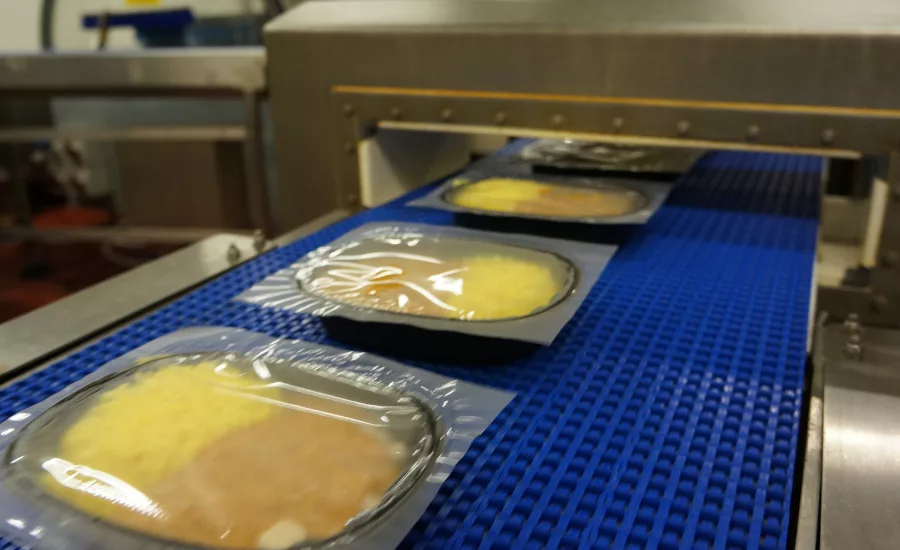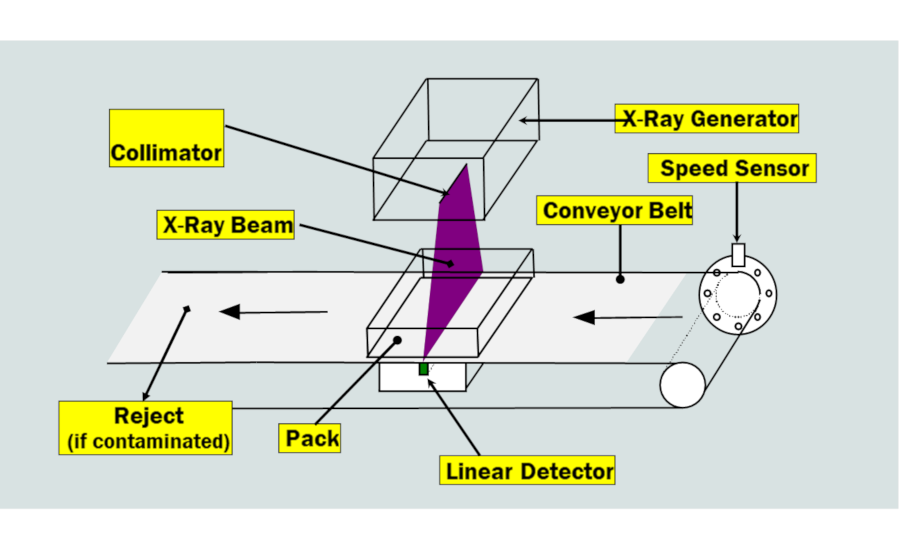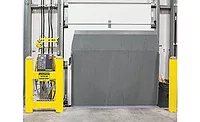Managing foreign materials
Equipment is important, but a foreign materials management program must go beyond that

As food moves through the production process, foreign matter detective via metal detectors or X-ray inspection is a critical component of ensuring quality and safety. Photo credit: Getty Images/ GAnnison
The programs that many food processors adopt to manage foreign materials often focus solely on the equipment that they install to detect and remove foreign materials, especially metals.
Foreign material management is and must be much more than that, however. It includes vendor approval and quality programs, good manufacturing practices, employee guidelines and education, cleaning and sanitizing, glass and brittle plastics, preventive maintenance and pest management. One of the reasons that processors should develop, document, implement and maintain such programs is to help keep foreign materials out of the foods being manufactured. There are several reasons to keep foreign materials out of foods. These include, but are not limited to, the following:
- Food safety: Protecting consumers from illness or injury.
- Prevention of adulteration: If a processor knows or suspects a product contains foreign materials, it is deemed adulterated and cannot be sold or must be recalled.
- Food quality: Foreign material will compromise food quality.
- Consumer satisfaction: Consumers expect foods to meet their expectations. Finding a foreign object in a food could result in a lost customer; the wrong way to go in a business that relies on repeat sales.
Keeping foreign materials out of foods is essential since the magnets, metal detectors and X-ray machines that processors rely so much on have certain limitations; limitations that will be discussed in greater detail later. They simply do not detect and remove all foreign materials, so it is imperative to keep certain things out of the foods. These include materials such as insects and insect parts; hair; pieces of cloth; wood; and different kinds of packaging materials such as plastics, jute or cardboard. The focus of this piece will not be these preliminary programs that are aimed at keeping things out, but the metal detectors and X-ray machines used to detect and eliminate materials from foods or ingredients during the process flow.
Defining hazards
In Section 555.425 – Food – Adulteration involving hard or sharp foreign objects, the FDA has defined what a significant food hazard is:
a. The product contains a hard or sharp foreign object that measures 7 mm to 25 mm, in length.
and
The product is ready-to-eat (RTE), or according to instructions or other guidance or requirements, it requires only minimal preparation steps, e.g., heating, that would not eliminate, invalidate, or neutralize the hazard prior to consumption.
Samples found to contain foreign objects that meet criteria a. and b., above should be considered adulterated within the meaning of 21 U.S.C. 342(a)(1).
This document is what most companies use when defining what and when foreign materials may be defined as a significant hazard. It is also referenced in the Hazards Guide the agency has established for seafood (Chapter 20) and for juice. Of course, if the processor suspects that a product contains foreign materials, even if the contaminants are very small, the product should not be sold as it may be adulterated. And, it is illegal to knowingly distribute products that are adulterated. Metal and glass are the most significant hazards that food processors look to manage.
The role of metal detection
Metal detection has become an integral unit operation in many process operations. The 4th Edition of the Seafood Hazards Guide addresses metal inclusion in Chapter 20 and emphasizes the importance of properly calibrating metal detectors based on the type of product, the state of the product (frozen, fresh, etc.) and the type of package. There are similar recommendations in the FDA’s guidance for the juice HACCP regulation.
When setting up a metal detector, the goal will be to ensure that the unit operates at the greatest sensitivity possible. This is done to ensure the greatest protection against metal contamination. With gate type units, a wide range of products may be tested. This includes almost all kinds of foods, including packaged products in non-metallic systems, unpackaged products, frozen products, fresh foods, dry food and even cased items. The gates or apertures should be as small as possible to ensure greater sensitivity. The equipment manufacturer should help the processor select the best unit for the application and help set up the system, which should include initial validation. For a product such as pasta in a cardboard box, the sensitivities might be 1.0 mm for ferrous metals, 1.5 mm for non-ferrous metals and 2.0 mm for stainless steel whereas a case of frozen omelets might be set up with 4.0 mm for ferrous, 4.5 mm for non-ferrous metals and 5.0 mm for stainless steel.
Metal detectors operate continuously, that is, each and every product on the line will pass through the unit. The processor must establish a program to verify that the system is working. At a minimum, processors should run their test standards through the unit as the start of each production run, in the middle of the run and at the end of the run. In reality, most processors will run the test standards at the beginning and end of each run and at intervals in between ranging from one to two hours.

A typical X-ray system setup. Chart courtesy of Thermo Fisher Scientific
Processors should understand potential issues with their metal detector and the products that they are manufacturing. As an example, may processors package products in fiberboard cartons (noodles, rice, pasta) that have been manufactured from recycled cardboard. Occasionally the recycled packaging contains metal fragments which will be kicked out by the detector, yet when the processor looks at the product itself, they find nothing. The investigation to find and identify the metal must, therefore, look at the package and product.
According to Eric Confer, market manager, light industrial, Eriez, the following steps help guide clients into the appropriate detection system by taking into account several factors. They are:
a. What are the goals of the detection system at the point of use? Some examples would be, are we protecting downstream equipment or minimizing the potential of product liability with finished packaged goods? The goals of the client’s process are truly the most important.
b. How is the product(s) currently being processed? We try to offer a detector that naturally integrates into their process without causing new problems like bottlenecks or maintenance challenges.
c. Ideally, when we specify a piece of equipment, we test the product(s) on a similar or identical system in our central test lab. This allows us to get a “closer to production” sensitivity validation for the client. We then engage with the client to discuss the performance of the metal detector and what they would expect upon receiving their metal detector.
d. More than anything, we focus on giving the client the confidence and quality information necessary to make such a large purchase. Couple that with service and support after the sale, and we can ensure the client will have a reliable system with the best possible sensitivities for years to come.
X-ray detection
The use of X-ray detection has increased throughout the industry. The driving forces have been improving technology, enhance line speeds and reduced costs. In addition, more processors are interested in being able to detect foreign materials other than metals. X-ray detectors may be used to eliminate glass, stones, hard plastics, and other materials since the technology operates on the basic principle of density differentials. Lastly, X-ray detection technology can be used for metallized packaging such as boil-in-bag products and foil wrapped items. And, X-ray inspection systems have other capabilities. They can be used to conform fill levels, monitor seal integrity, mass analysis and can detect missing product.
It is not, however, a panacea. Products like breakfast bars or candies with large inclusions such as almonds or peanuts require special attention.
“The density of nut inclusions in bars is lower than that of the contaminants that are usually being inspected for, so in general, with the right set of inspection algorithms, nut inclusions can be ignored and a successful inspection made,” says Mike Munnelly, field manager, Thermo Fisher Scientific. “That being said, the application can be challenging because the position of the nuts in the bar is random so comparing with a known good image is not possible. If there is any doubt, then the best way to determine how an X-ray system will perform on a particular application is to work with an inspection equipment vendor to perform a product test using actual production samples with the X-ray system of interest.”
In addition, there are foreign objects that will not be detectable due to lack of density differentials. These include pits from cherries, apricots and pears and un-calcified bone such as may be found in immature chickens or fish fillets. Processors interested in adopting an X-ray detection system should also check on local regulatory or environmental regulations. One California processor installed an X-ray detection system for boil-in-bag products in a foil laminate packaging and was informed by local authorities that it needed a special permit for the “nuclear device.”
Munnelly also notes that large, bulky products can be a challenge for X-ray systems.
“Products that are very large and bulky can be a challenge for X-ray,” says Munnelly. “A large X-ray aperture and a high-powered source would be necessary for inspection, which quickly can become impractical due to cost, size, etc. Metal detectors on the other hand are easier to scale-up in size, and a great fit for large unprocessed foods such as those at the very beginning of the processing line.”
Many buyers are now encouraging their suppliers to adopt X-ray inspection technology. Costco’s guidance for suppliers includes the following statement:
Foreign material detection devices, such as X-ray and metal detectors, are an important final step to ensuring that product which has been manufactured under appropriate controls is free of physical contaminants. If you are considering purchasing a foreign material detection device, Costco would like you to weigh the benefits of X-ray over metal detection for your facility. X-ray can not only pick out metal, but also is able to determine densities of rubber, plastic, bone fragments along with sticks or twigs.
Processors should validate the unit for each product as described for the metal detectors and establish a schedule to verify that the system is working. Test standards for X-ray detectors include metals, glass or silica, bone and hard plastics. Sensitivity depends upon the type of unit.
X-ray systems may also be employed to detect and eliminate potential contamination in finished products. Processors can rent or lease a system or send a suspect lot for X-ray scanning to third parties. One processor with whom I worked found that their filler was missing a gasket at the end of a production run. They assumed it was in the product but could not find it through inspection. They leased an X-ray detection system and ran the suspect product through with the help of the contractor. They discovered all the pieces of the gasket and were able to release the lot.
Enhanced detection
There are companies that utilize both metal detectors and X-ray systems. Running these systems in tandem enhances the ability to detect and eliminate foreign materials. It is also something that processors can show to clients and auditors to demonstrate their commitment to minimizing the potential for physical hazards. In fact, some operators go one step further and have installed plate magnets just upstream of their packing operations. This may seem like overkill, but I have observed that this last intervention is effective, especially when it comes to removing rust particles which are about the size of dust. Processors of various kinds of fruits and vegetables also employ X-ray detectors to protect equipment by placing them upstream of cutters, grinders and choppers. The detectors remove materials such as glass, stones and other materials that might damage the blades. The metal detectors are deployed downstream from the cutters, grinders and choppers.
Most processors focus their Food Safety Management Systems (FSMS) on the biological hazards, but one cannot ignore physical hazards. They can injure persons and/or sour a person on a product.
No likes to find surprises in their food. Remember the old joke: “What’s worse than finding a worm in your apple? Finding half a worm.”
FOR ADDITIONAL INFORMATION
Thermo Fisher Scientific – www.thermofisher.com and thermo-scientific-ebook-a-practical-guide-to-metal-detection-and-xray-inspection-of-food_.pdf (mdpackaging.com)
Eriez – www.eriez.com
Looking for a reprint of this article?
From high-res PDFs to custom plaques, order your copy today!






